
archives for 04/2018
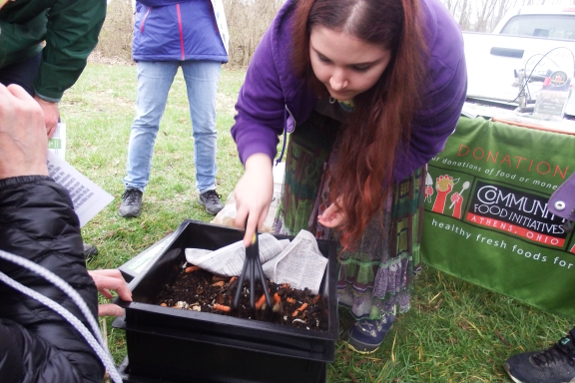
Laura Diaco from Rural
Action regaled a group of attendees with pro tips on making indoor worm
bins pull their weight earlier in the week. Mark and I have played
with composting worms quite a bit, but I still came away with
a few excellent tips.
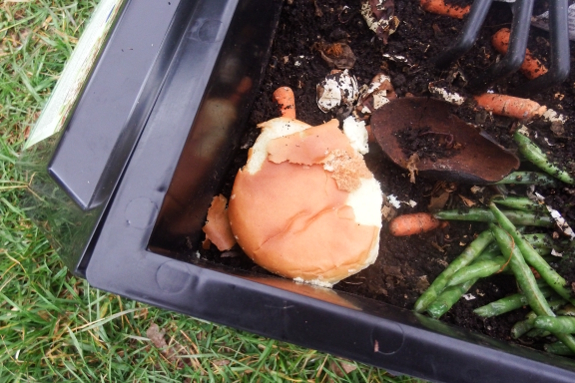
First --- skip putting
onions, garlic, and citrus in your worm bins. (This was one of my first
beginner mistakes back in the day.) Second, freeze food scraps before
use to kill fruit flies. (Yep, this was the second problem we had with
our original bin.) And, third, you can apply a piece of bread dosed
with milk to attract springtails if you experience a population boom,
removing the "trap crop" along with the unwanted critters to cleanse
the bin.
Laura had so much
success with her bin that she had to use a
starvation diet to slim her population down to the point where she
could continue to bring the demonstration unit to events. Otherwise, it
was starting to get too heavy for her to lift! Clearly, she has a way
with the worms.
I've been doing more film
making than homesteading these past few weeks.
This is a photo from an
upcoming comedy titled "Intense Excitement".
My role on this film is Unit
Production Manager.
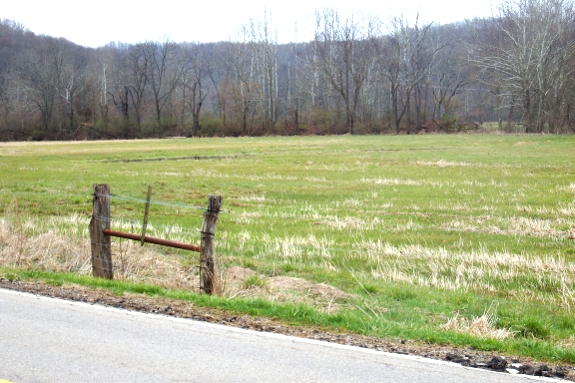
Our new
bales of straw were
cut from a perennial --- canary reedgrass, which grows in soupy ground
down by a creek. The farmer reports:
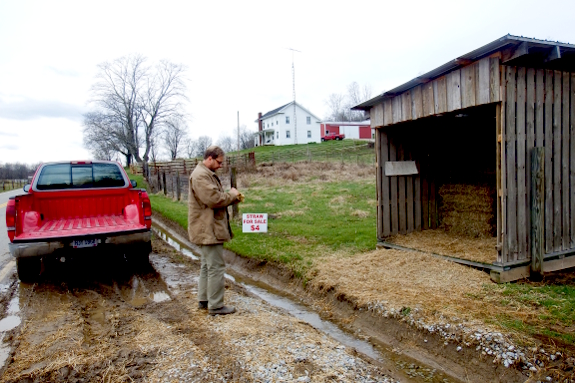
Clearly, the demand for
his straw is high. The farmer has just about sold out, having moved
1,000 bales using a self-serve kiosk by the side of the road over the
course of the winter and spring.
I'll try to remember to
report back once I have more of an idea of the pros and cons of using
this perennial straw in the garden. For now, I suspect it'll rot a
little faster since it has more of a grass feel than a straw feel, but
will otherwise work as expected. Stay tuned for further details!
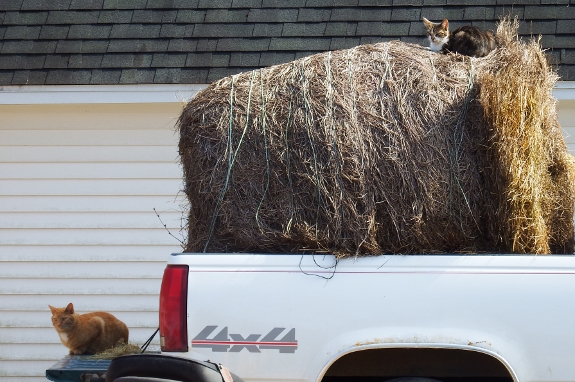
These handsome cats were
photographed at our neighbor's house.
Not hard to figure out which
one is the Alpha cat of the two.
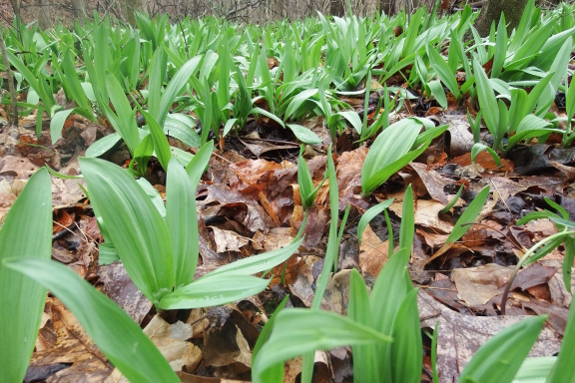
When I hiked past the
first cluster of ramps (more specifically, Burdick's wild leeks) last
week, I yearned to sample but didn't want to damage a wild population.
Then, a few days later, I stumbled upon the motherlode --- over an acre
in size, with evidence of last year's flower stalks promising a mature
population. Time to finally taste some ramps!
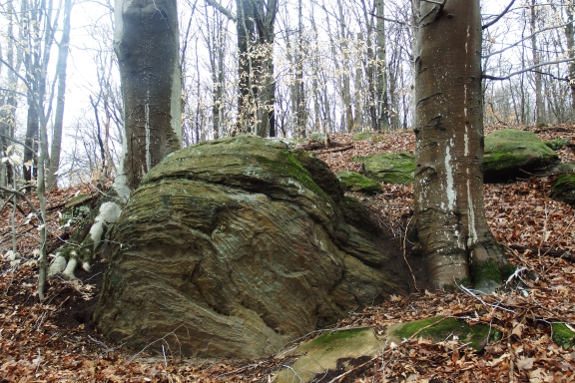
I still only harvested a
handful, not wanting to damage such a slow-growing plant. But they
certainly made for deliciously flavored biscuits, and I have several
more recipes I want to try. Good thing ramps seem to be overharvested
much less in Ohio than they were in Virginia!

Anna recruited some local girl power to help spread more grass seed and straw.
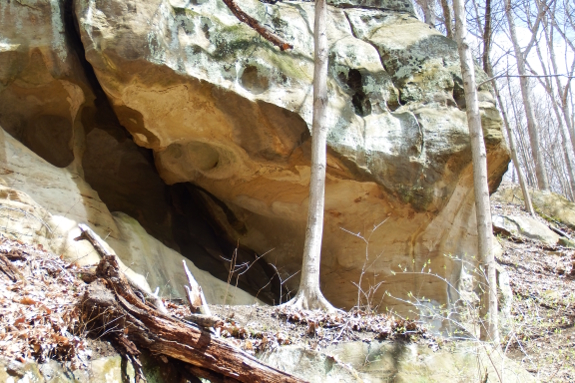
I finally found the
spring flower motherlode in the region --- the aptly named Rockhouse
Trail at Sells Park. South-facing, mature
forest, full of limestone, and quite damp adds up to the perfect
habitat for early spring ephemerals.
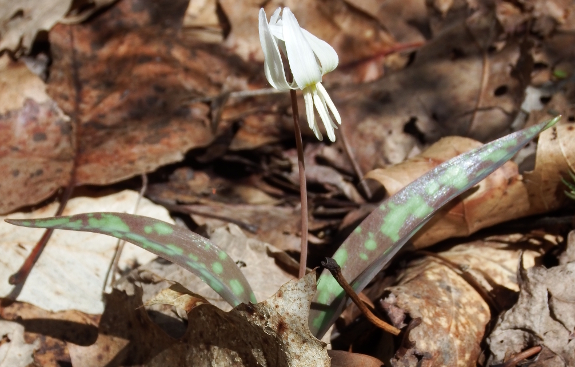
I'm enjoying the fact
that a new stomping grounds means new species to ID and enjoy. For
example, the trout lilies here are white rather than yellow. (The
yellows should live here too --- I'll keep my eyes open.)
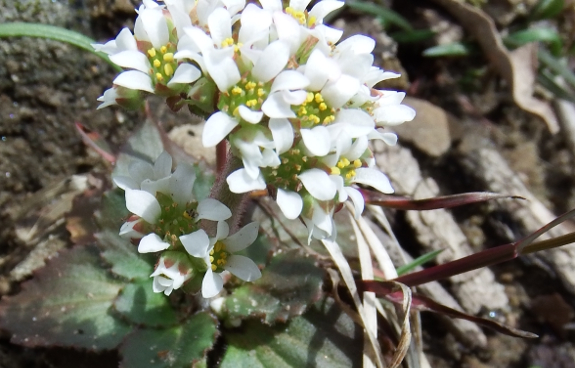
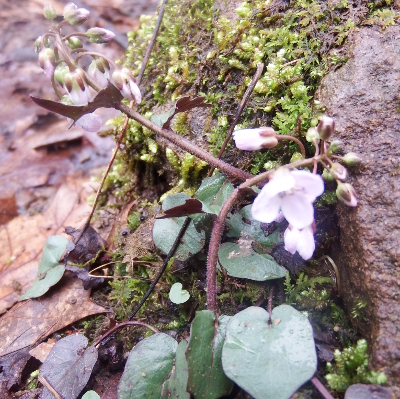 Even less familiar were the
rock-loving Early Saxifrage above and the damp-loving Limestone
Bittercress to the left. Given the ubiquitousness of the latter species
on one of my other favorite trails, though, I suspect this will become
a new spring favorite.
Even less familiar were the
rock-loving Early Saxifrage above and the damp-loving Limestone
Bittercress to the left. Given the ubiquitousness of the latter species
on one of my other favorite trails, though, I suspect this will become
a new spring favorite.
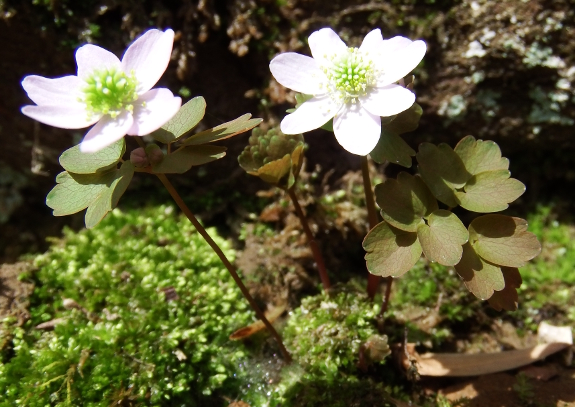
Of course, my old
friends are nearby too. Toothworts and spring beauties by the
bucketload, hepatica nearly done already, and --- once I peered a
little closer --- I even found a couple of bloodroot and rue anemones.
Phew! Wouldn't want to miss out on the flowers I grew up with even as I
add new ones to my mental roadmap of spring!
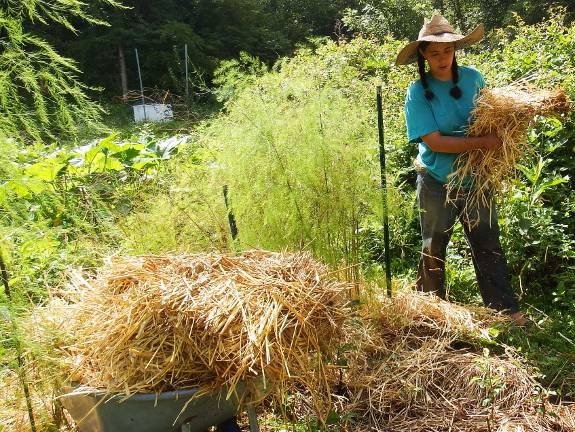
I miss the huge servings of asparagus that will be popping up there later this month.
Anna misses the composting toilet and creek.
Want to create homesteading memories of your own? All 58 acres are still for sale for one low price of $79,333.
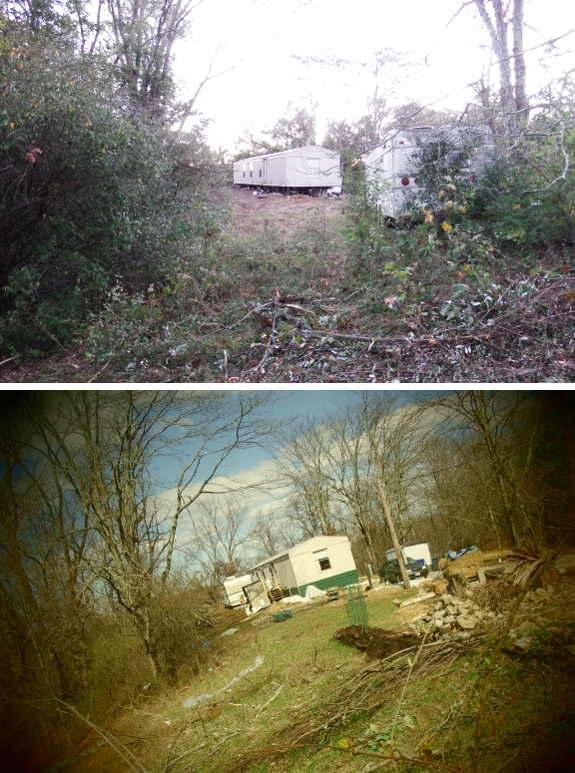
I can hardly believe
we've been here six months! On the one hand, it feels like we arrived
yesterday; on the other hand, it feels like we've been here forever.
And, as the pictures prove, we have made a fair amount of
progress over the last six months.
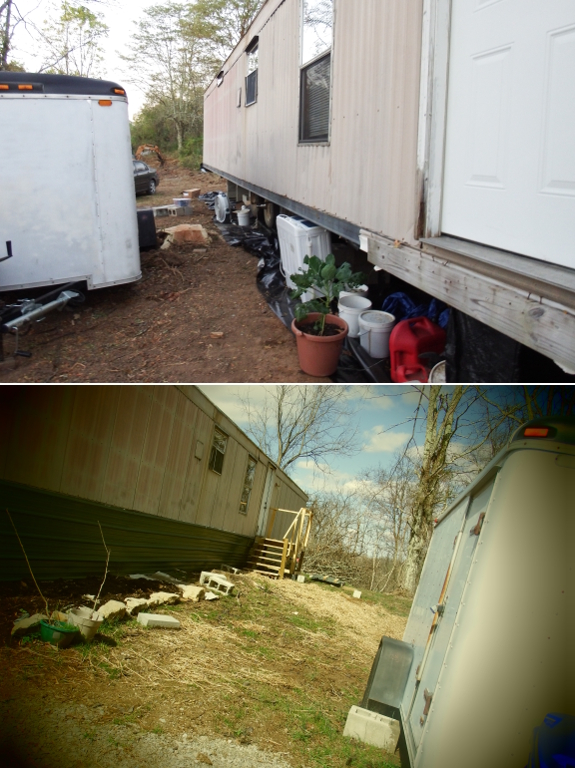
First the property went
from a bare tract of land to a liveable homestead complete with
trailer, water, septic, and electricity.
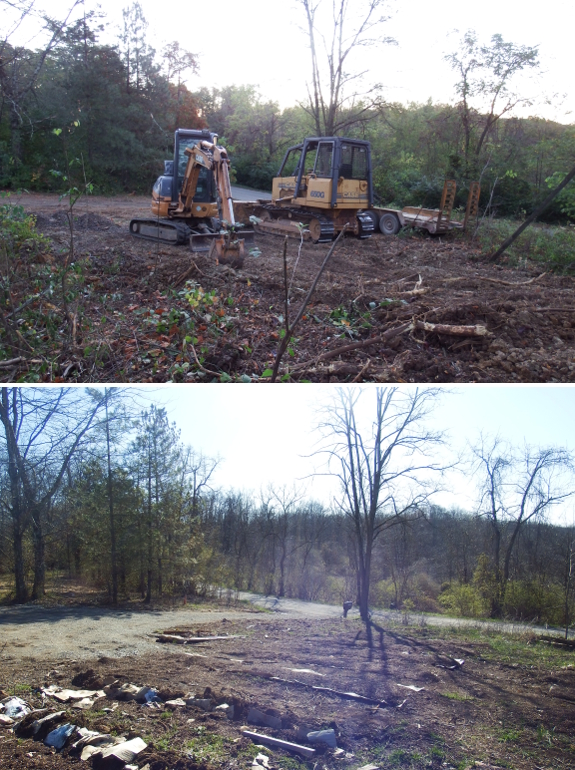
Next comes the garden.
We've laid out a bunch of beds and planted several. (The confusing bits
in the foreground are where I laid down kill mulches then realized
those areas were going to be asparagus and had to dig them right back
up.)
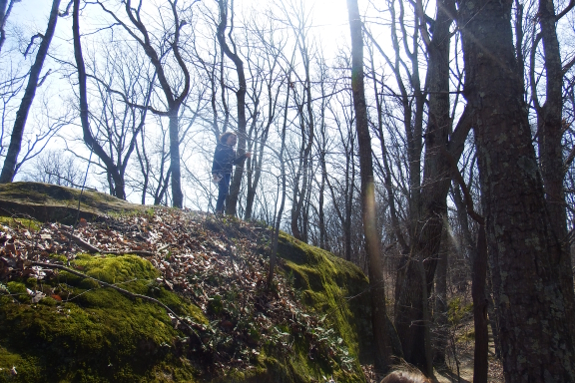
And, most importantly,
we've met an astonishing number of talented and interesting people,
like the aspiring videographer, cupcake baker, and truck driver who
helped me take the "after" photos in this series.
Our 1997 truck has quickly
become a valuable part of our homesteading team.
I took this picture to
document the worst section of rust.
Eventually I should try
something that might help slow the rust from spreading but I guess I'm
curious at what rate the hole will get bigger and if I'm okay putting
it off for another year or so.

Last week was a
multicultural week on the campus of Ohio University. Even though the
events were mostly for students, I insinuated myself into a couple
anyway.
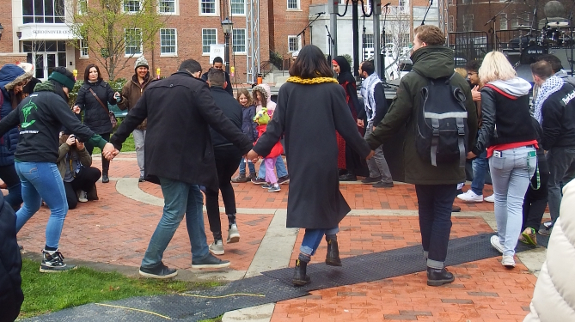
The International Street
Fair didn't require insinuation --- it's an open-to-the-public event in
which you can try your hand at Chinese writing, sample delicious ethnic
foods, and even watch and participate in a few dances. Can you find me
in this rousing rendition of the Arabic dabke? (Thanks for snapping the
shot, Jen!)

Even more visually
stimulating was the Native American Dance and Song Workshop, which was
really just for students, faculty, and staff. They let me in, though,
and I loved the drum beat, which we were told is meant to mimic the
beating of the heart.
Okay, I'll admit it,
there's nothing homesteading-related about this post. Except...don't
forget to spend time expanding your horizons and feeding your mind as
well as your belly!
We decided to expand our
sweet potato family to include Covington.
Now is the time to start encouraging seedling activity.
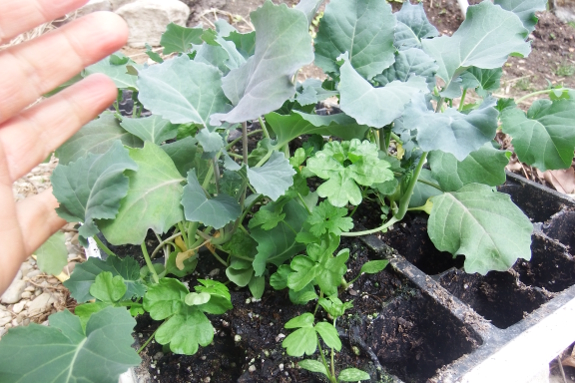
With the spring garden,
I plant by feel rather than by spreadsheet. So when the weather turned
warm and wet for a week at the end of March, I set out a lot of things
that likely shouldn't really have been planted then. Of course, then
last week's cold spell hit (mid twenties and a couple of inches of
snow), which left me scurrying to cover everything up and hope my
babies would survive.
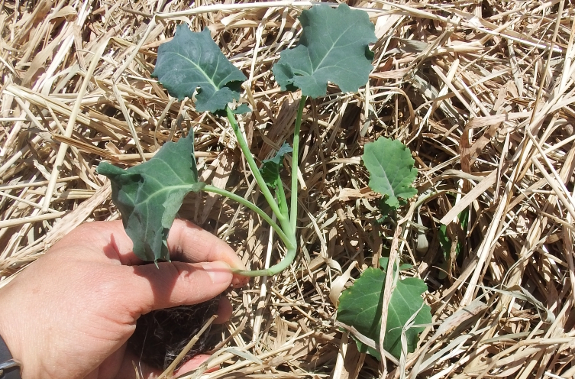
Now's the moment of
truth --- did I make a mistake? On the broccoli front, I probably would
have been better off waiting. None of the outside plants were damaged
badly enough to need to be replaced when I gave them a once-over
yesterday, but they were also significantly smaller than the ones still
in a flat inside. I set out another couple of beds with reserved plants
and will be curious to see which planting date leads to the earliest
and best heads.
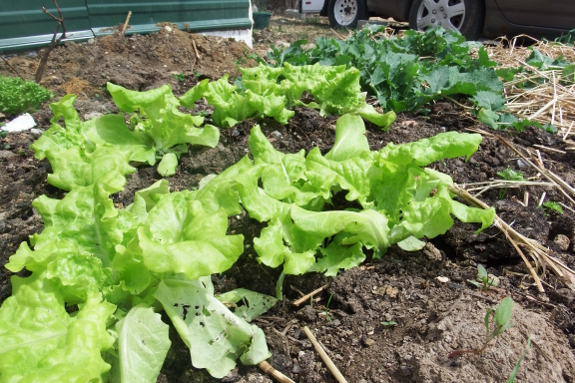
On the other hand,
lettuce, thyme, parsley, and peas also transplanted on March 27 passed
the cold-weather test with flying colors (although the row-cover fabric
I had over them until this week certainly helped).
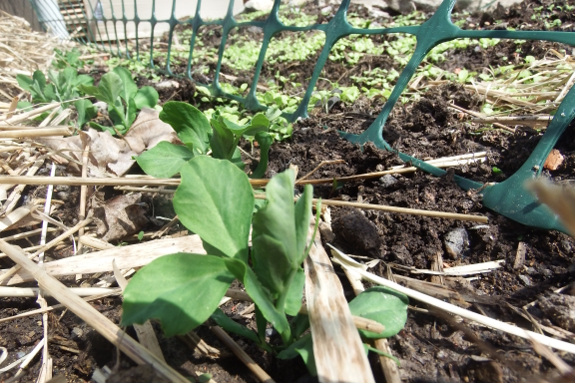
And how about the
direct-seeded vegetables? They look pleased as punch now that their row
cover is off and they're once again exposed to full sun. Soon we'll be
rolling in lettuce and peas!
We got to see a sneak preview
of the new Athens Ohio Maker Space.
The wood shop has most of the
big wood working tools.
A punch card is what we will
start with where you pay per visit compared to 70 dollars a month for
more serious Makers.
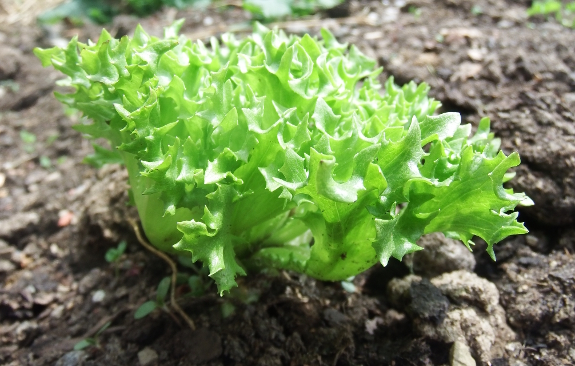
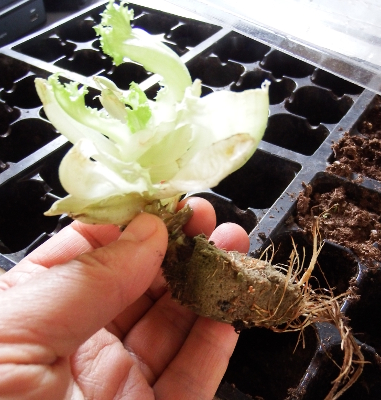 I'd read about folks planting
carrot tops and other detritus from their salad-making, but hadn't been
buying enough grocery-store produce to even consider giving it a try.
But when the lettuce head at the left ended up in our kitchen this
winter with a big mass of roots still attached, I couldn't resist the
urge to set it out in the garden.
I'd read about folks planting
carrot tops and other detritus from their salad-making, but hadn't been
buying enough grocery-store produce to even consider giving it a try.
But when the lettuce head at the left ended up in our kitchen this
winter with a big mass of roots still attached, I couldn't resist the
urge to set it out in the garden.I planted that lettuce under a quick hoop in the middle of February...and it sat there for weeks doing nothing at all. The photo at the top of this post shows the plant's current state nearly two months later. It's finally almost large enough to pick a few leaves from...although, for the sake of comparison, leaf lettuce direct-seeded on the same date is nearly as big:
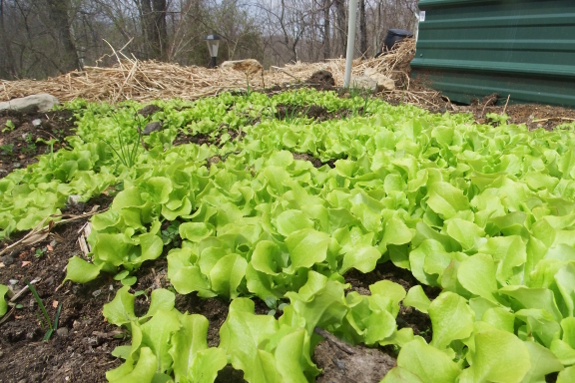
What's with that lettuce
root growing so slowly? I suspect that February lettuce from Krogers is
hydroponic produce grown at the perfect temperature and nutrient
levels. In the wild weather of an Ohio garden, hot-house varieties are
going to lose the sprint to harvest to my hardy Black-seeded Simpson
every time.
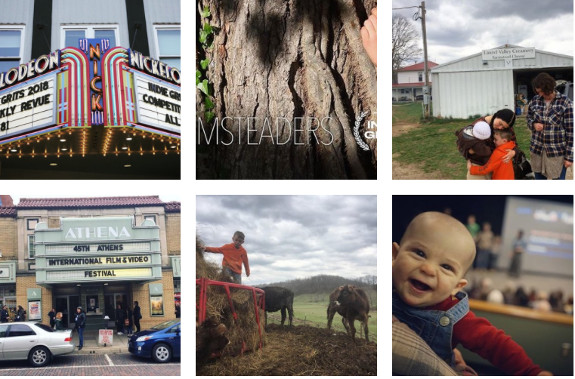
We watched a sweet and
beautiful documentary about a local cheese making family Sunday at the
2018 Athens International Film Festival.
Farmsteaders is a unique glimpse
into a small cheese making operation over the course of 5 years.
The cinematography is stellar
and you really get drawn into the joy and struggles of what it takes to
get the cheese made and sold.
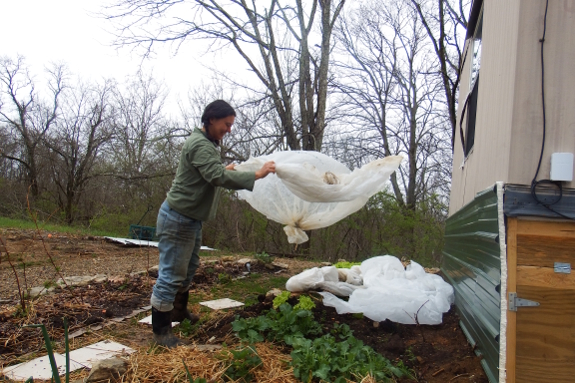
I looked back through
the blog and found that I seldom mentioned Redbud Winter in the past.
I'm not sure whether that's because I was planting at a more reasonable
time back in Virginia or whether we just tended to get cold spells a
week or so later (at which point it becomes Dogwood Winter).
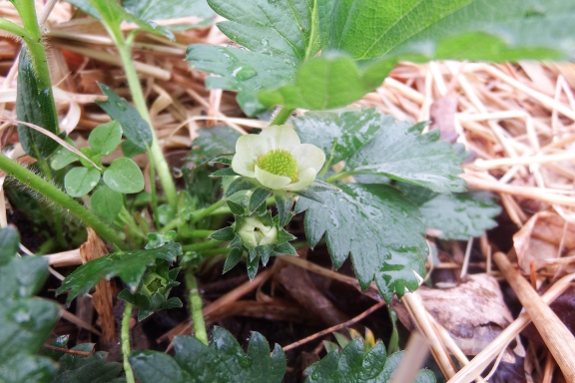
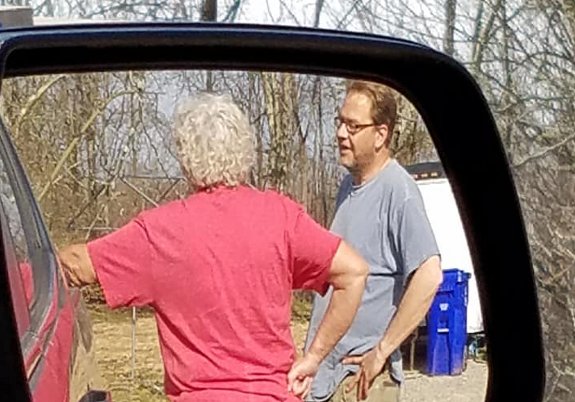
Mirror image of my Mom and me talking about trading a cow for magic beans.
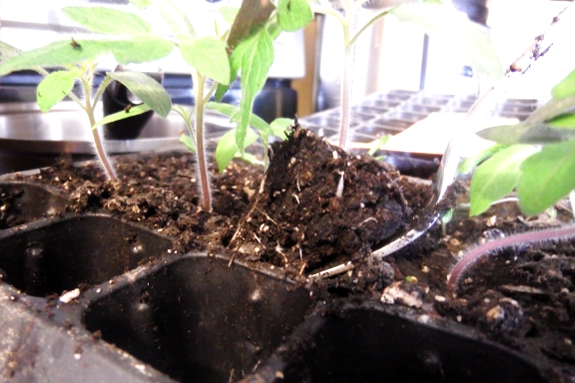
Monday was potting-up
day for the nightshade family. Tomatoes, of course...
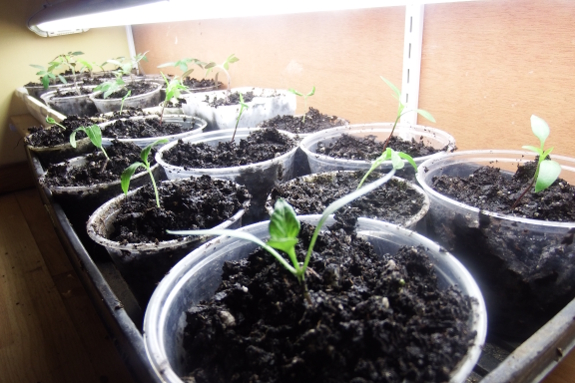
...our favorite lunchbox
peppers...
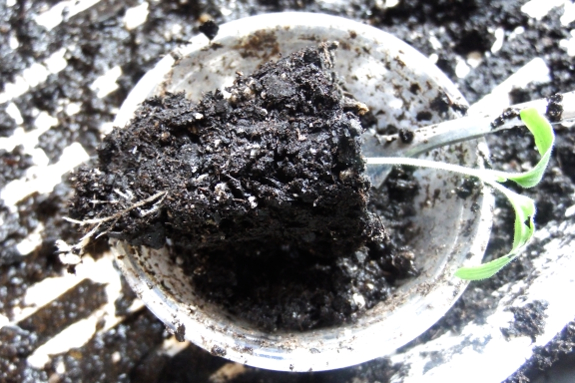
...and even a few
eggplants. I'm not sure I'll be able to prevent flea beetle
depredations organically (the reason I usually skip this crop), but I
saw a guy selling heirloom seeds at the farmer's market and couldn't
resist.
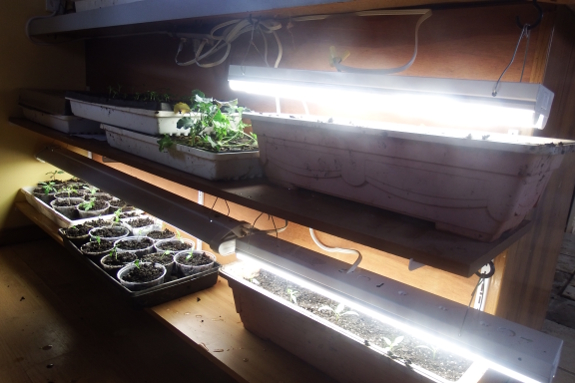
Aaaand now we need a
fourth shop light.
Spring close up of one of the few Egyptian Onions that made the trip North with us.
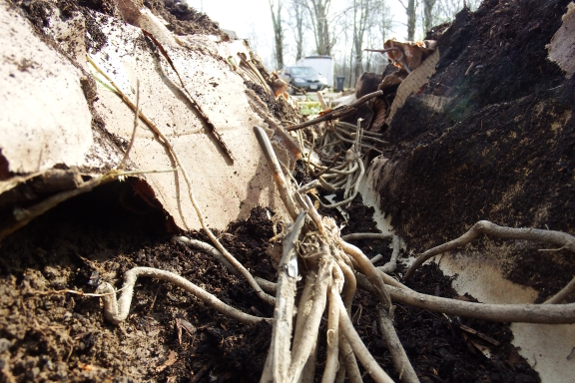
Rose Nell gave us five
Purple Passion asparagus roots to join the 25 Jersey Knight we ordered
online. The latter is what grew so wonderfully for us in Virginia, so
we'll be very curious to see if this new purple variety is as tasty and
productive.
Only after we both
ordered and received our roots online did we drop by White's Mill...and
find the exact same varieties available there for a lower price before
we even factored in shipping. I guess I need to start checking out our
local establishments before placing perennial orders from now on!
It's been about a year since
our first
experiment with a roll out nest tray.
One thing I would do
differently would be to mount the tray so the angle could be adjusted
depending on how the chicken tractor was sitting on uneven ground.
It might be better suited for
chicken coops that remain stationary all day.
I really like the idea of keeping eggs clean with the help of gravity
and will continue to pursue this concept if we ever decide to get
chickens again.
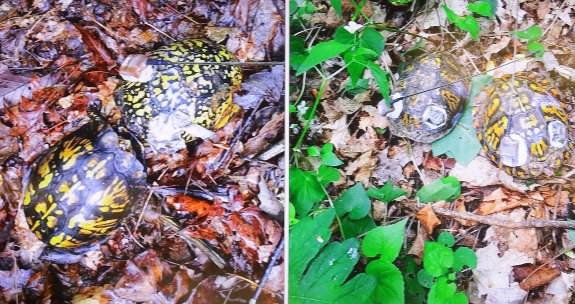
Did you know that box
turtles are sociable? They sometimes hang out together without any
apparent mating or territorial maneuvering going on.
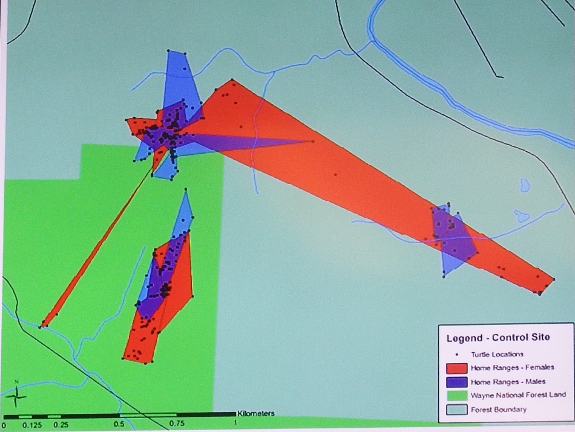
Did you know that female
box turtles have much larger home ranges than males do? (Up to 50 acres
vs. 7 acres or less.) This may be because the females sometimes travel
long distances pretty fast when the time comes to lay their eggs. Take
a look at that long, skinny red polygon above as an example of
beeline-to-the-nest-site behavior.
A male box turtle, on
the other hand, might spend his entire summer under the same blackberry
bush subsisting on fallen fruit, worms, and bugs. Perhaps this is why
male turtles have lower levels of stress hormones in their blood than
females do?
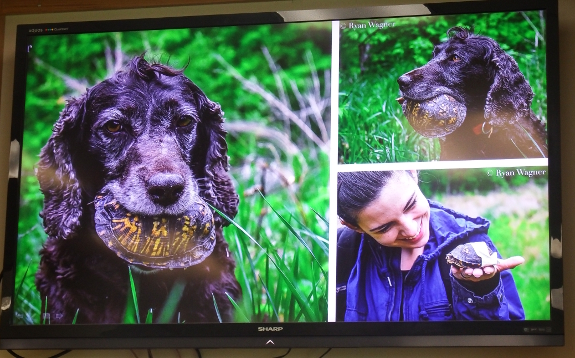
Marcel Weigand
discovered all this and more with the help of both human and canine
field assistants who found, tagged, then revisited several test
subjects over the course of last year. She shared her findings at the
Athens Public Library Saturday and, impressively, one of four teenage
neighbors willingly sat through the entire hour.
Did we bring the Super
Winch with hitch
mount with us on the move
North?
We sold it to our neighbor
James for a fair price before we left.
He would get more use out of
it since our new land is more high and dry.
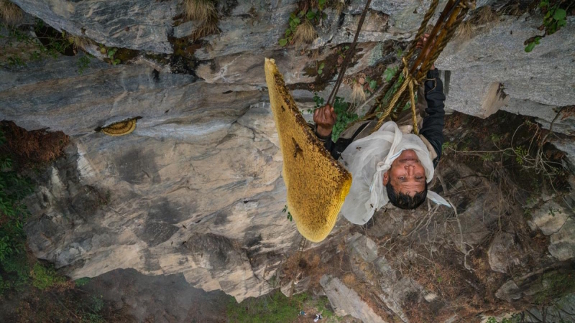
While I enjoyed the
Farmsteaders movie
that Mark posted about, my favorite viewing from the recent film
festival was The
Last Honey Hunter. I
went into it expecting a documentary and instead got a visual yet
symphony-like experience, as if I'd actually been in Nepal climbing
massively high cliffs in search of taboo and at the same time medicinal
honey (an overdose of which can easily kill you).
The film is just over
half an hour long, and if you get a chance I highly recommend indulging
in the experience.
We get a fair amount of
turkey traffic patrolling our garden area.
I wonder if the Ozark
turkey trap would work if we got really hungry?
Good thing we have the big
garden fence next on the list of things to do.
We learned at the recent
Maker Space tour that
their Tool Library has one of those motorized
Earth augers for digging deep post holes which I think we'll
experiment with and see if it's good enough for the dirt we are dealing
with.
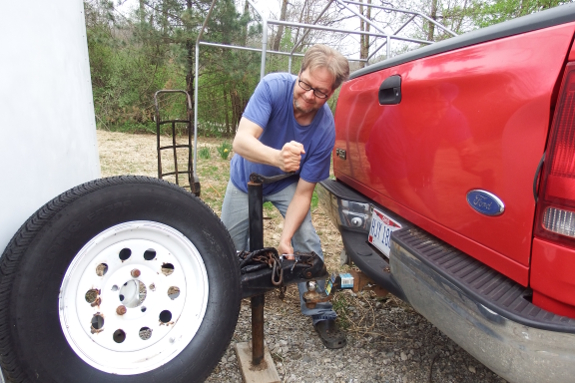
You know you're fully
moved in when you finally return the moving trailer you borrowed to
haul your possessions north.
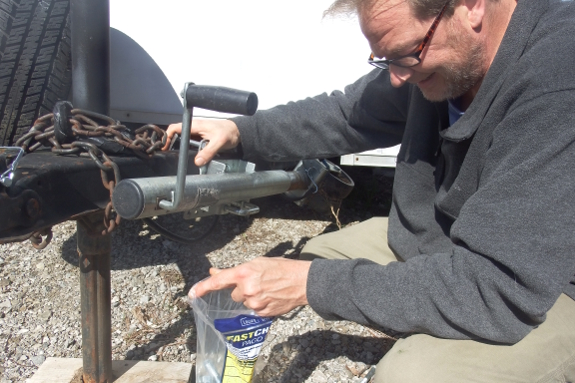
Before we sent the
trailer home, though, we had to fix the bolt-on
jack wheel which had
bent during previous usage. These handy devices swivel down to form a
fifth wheel for easy repositioning of an unloaded trailer. Be sure you
don't exceed the weight limit, though, or you may bend bolts and have
to replace the entire attachment mechanism!
I've been volunteering on
some local student film crews this month.
One thing I've learned is how
important it is to serve a good meal to a crew of film makers working
for free.
The catering I did this week
helped me to understand how much work is involved in preparing food for
a medium group of people.
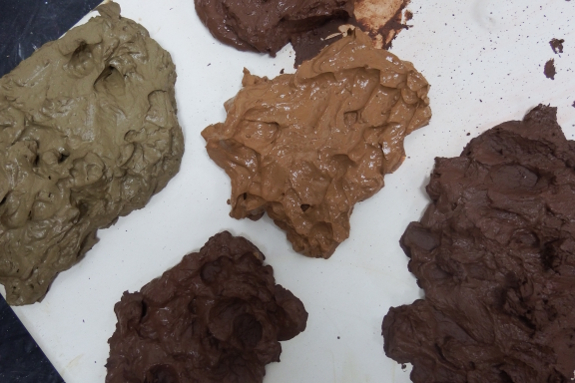
Jenn and I attended a
fascinating workshop at the Dairy Barn Saturday about digging clay out
of the earth and turning it into pottery. I was surprised to learn how
simple it is to process wild clay...although the techniques can be
quite time-consuming.
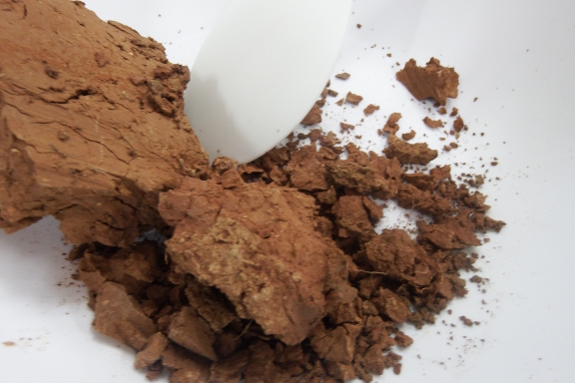
The first step is to
collect your clay. For best results, gather clay from within twenty
inches of the surface since this weathered clay will do better. You're
likely to find gray clays under coal seams and red clays elsewhere.
Both are good pottery clays if you live in our area.
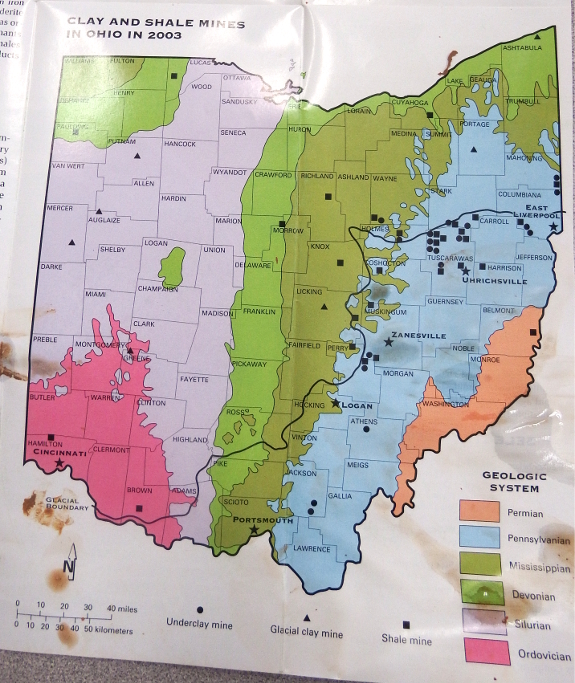
In fact, I was surprised
to learn that southeast Ohio is the clay capital of the world! Over
half the pottery made worldwide in the last one hundred years began as
clay in Ohio soil.
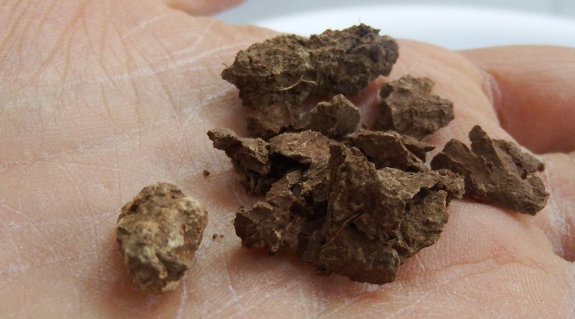
Okay, geography lesson
over. What do you do with your wild-sourced clay?
First, let it dry out
thoroughly. Then break the big lumps into smaller pieces, removing
pebbles and roots in the process. The most important pieces to take out
are small inclusions of limestone (the paler lump on the left in the
photo above) since limestone messes with the moisture content of clay
and can cause explosions in the kiln.
Breaking up the clay can
be done with your hands or with a hammer on the small scale. On a
larger scale, you'll want to use a hammermill of some sort.
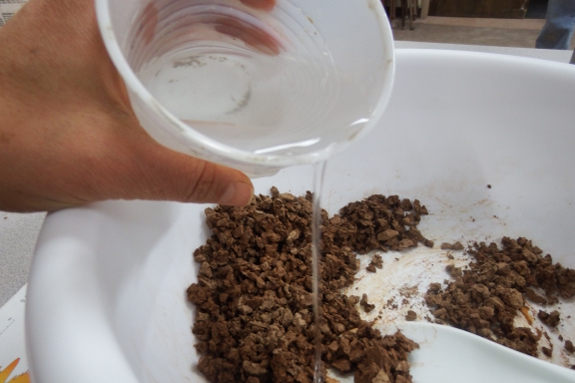
Next, you'll have to
choose whether to wet-screen or to dry-screen your clay. Wet screening
is safer --- inhaling clay dust can make you very sick. But dry
screening is much easier to mechanize and perform in bulk using a
20-mesh screen shaken by an off-balance motor.
We wet-screened in our
workshop. First, add water...
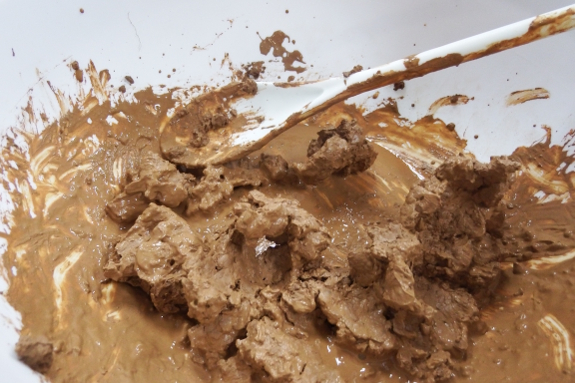
Then mix with a spoon or
by hand. By hand is messy but much more effective.
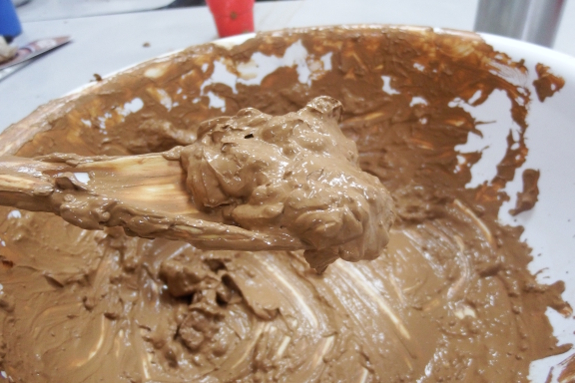
Your goal is to achieve
milkshake consistency, working all of the little lumps into the main
mass of clay. On a medium scale, you can do this mixing in a bucket
with a dry-wall mixer drill attachment a
bit like this. Or
just squeeze it through your fist over and over on the small scale.
As a side note, if your
clay isn't very dry, it's actually much harder to moisten thoroughly.
In this case, drop the clay in a bucket of water and leave it for a few
days to soak up the liquid rather than trying to force water in quickly.
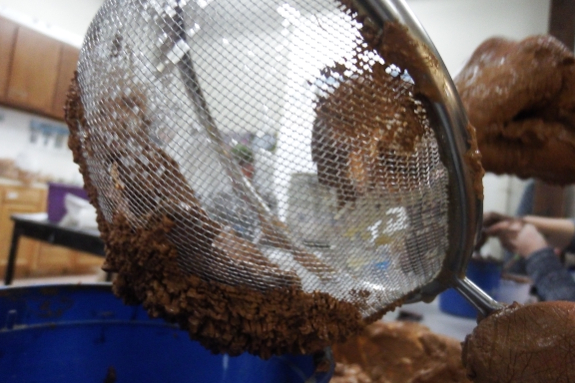
Now it's time to pass
the wet clay through a screen to pull out the last of the rocks and
roots. I found that it's easiest to press the wet slip through the
sieve with my fingers.
Then put the screened
clay on a board to dry somewhat (as in the photo at the top of this
post) and it's ready to use in hand-building, brick-making, or thrown
pottery. Our teacher suggested firing at cone 04 for most clays in our
area.
How about you? Have you
ever processed wild clay?
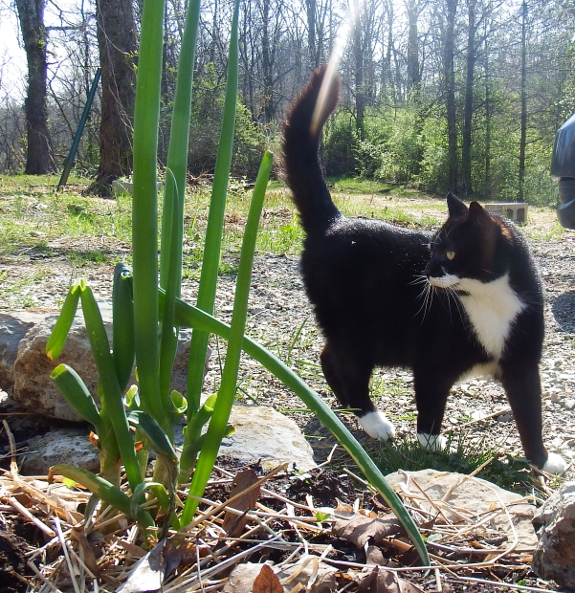
We've always had so many plants it wasn't a problem...until this spring.
To play it safe, we make sure each plant has one large and one small leaf on it at all times. That's enough to keep the bulb alive.
Want more in-depth information? Browse through our books.
Or explore more posts by date or by subject.
About us: Anna Hess and Mark Hamilton spent over a decade living self-sufficiently in the mountains of Virginia before moving north to start over from scratch in the foothills of Ohio. They've experimented with permaculture, no-till gardening, trailersteading, home-based microbusinesses and much more, writing about their adventures in both blogs and books.
